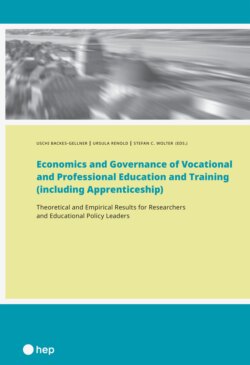Читать книгу Economics and Governance of Vocational and Professional Education and Training (including Apprenticeship) (E-Book) - Uschi Backes-Gellner - Страница 16
На сайте Литреса книга снята с продажи.
Governance and Configuration of National Institutions
ОглавлениеList placed the development of production forces at the center of economic interest and emphasized the long-term and future-oriented process. Furthermore, List placed the importance of social processes at the center of his argumentation, which requires state planning, institutions, and development under changed conditions. To increase productivity, the general education and qualification level of the population must be improved. The balance of skills must grow with the level of economic development.
Therefore, public funding of key elements of the education system is necessary for List. This funding would include all those elements that are unlikely to be provided by the market, including elementary and secondary schooling, institutions that mediate between education and work (such as the German Berufschulen), technical institutes, and scientific universities (List, 1991, pp. 81–82, in: Winch, 1998, p. 375).
List came to the conclusion that general education and on-the-job training (OJT) must be combined.
More advanced forms of production are likely to require relatively high levels of literacy, numeracy, and general knowledge. But trade-specific skills and attitudes are only learned properly in the workplace. Therefore, VET needs to combine the two in a system such as the German “dual system.” (List, 1991, pp. 200–201, in: Winch, 1998, p. 376)
This approach of combining OJT with general education contrasts with most educational concepts in the Anglo-Saxon area nowadays. The latter usually have separate subsystems. On the one hand, Anglo-Saxon areas have full-time general education or VET schools, which are part of the education system; on the other hand, they have subsequently organized labor-market integration programs, which are controlled by the employment authority and do not lead to a formal education qualification (Lerman, 2010; Ryan, 2000).
Finally, Winch (1998) pointed out that the approach proposed by List poses a greater challenge to governance. “What is most difficult to replicate, namely the density and complexity of institutions required to co-ordinate education and training: government, unions, employees, educational institutions of various kinds” (p. 377). Winch concluded that the Listian VET approach arises from the cultural and economic roots of society and cannot simply be imposed by a government. Without robust social institutions based on functional equivalences and a robust interplay of those social institutions, it will be very difficult to attain similar results (Renold et al., 2019). The comparison of the two economic perspectives shows differences in the framework conditions under which a political economy should be organized. Winch highlighted the consequences of such differences for the development of VET.
Therefore the changing of a VET system, similar to the changing of an education system more generally, is dependent upon and has ramifications throughout society and politics. It cannot be a simple matter of a technical recipe to aid economic growth, but touches on the heart of what any society is about. (Winch, 1998, p. 377)
